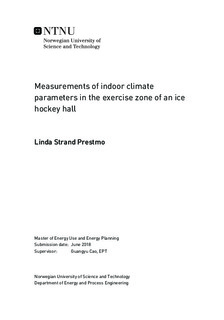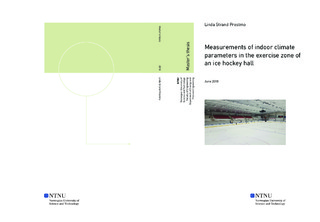| dc.description.abstract | The purpose of this thesis was to assess the indoor air quality at Dalgård ice hall in Trondheim. Ice halls are poorly regulated in Norway regarding guidelines for buildings and operation methods. This thesis will assess how one Norwegian ice hall is operated and the status of the indoor air quality inside the hall.
A literature study was performed and reviewed relevant studies and new research on ice halls and indoor climate. Several studies regarding indoor air quality in ice halls focused on pollution from the resurfacer, while new studies focused more on air distribution since many ice halls have shifted towards electric resurfacer.
Field measurements in order to assess the indoor air quality at the ice hall was conducted in several different ways. CO2 concentration, temperature and relative humidity was the parameters measured at the ice rink, while the sharpening room also had it s PM2.5 measured. CO2 concentration was measured on the ice rink during ice hockey matches by attaching the measurement equipment on the back of the referee. CO2 values during an ice hockey match was measured for four different athletic profiles: women, men, teenagers and children. The increase during a match ranged from 92 ppm to2 62ppm, and the concentration increased to above 1000 ppm during all measured matches which is the recommended value by the Norwegian Institute of Public Health.
Two different surveys was created. One was sent out to every Norwegian ice hall and mapped how many had fresh air supply and how many used recirculated air. Only 6 ice halls used only fresh air, while most used a combination between fresh air and recirculated air.
The other survey was sent out to the local ice hockey teams that used Dalgård for training purposes or for matches. This survey mapped how the players perceived the air quality at Dalgård. The majority of the participants were pleased with the air quality at the ice rink, with 98% choosing to describe it as acceptable or better.
The fresh air supply was assessed with measurements during two nights, and based on those results the air change per hour was calculated. The calculations proved that the amount of fresh air supply at Dalgård is dependent on the weather conditions. | |

